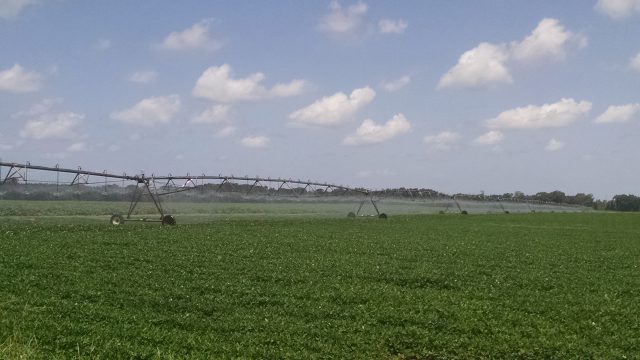
Producers in the Florida Panhandle can receive financial assistance from multiple agencies to defer the cost of implementing Best Management Practices on-farm, such as improving irrigation efficiency. Photo credit: Ethan Carter.
Farmers and ranchers have implemented Best Management Practices (BMPs) that maintain or improve water quality, quantity and soil conditions on their lands for many years. Although BMPs are designed to be technically feasible and economically viable, implementing BMPs can be expensive for producers, and some practices may not be financially viable for all. Multiple agencies in our region recognize this and offer financial assistance to defer the cost of implementing BMPs.
In most areas of the Panhandle, implementation of BMPs is still voluntary, but for producers in an area with a Basin Management Action Plan (BMAP), such as the Jackson Blue Springs/Merritts Mill Pond Basin, BMP implementation and verification is required.
Financial Assistance to Implement BMPs
The following agencies continually offer financial assistance for producers in our region to implement agricultural BMPs.
USDA-Natural Resources Conservation Service (NRCS)
NRCS offers financial assistance for farmers through two programs: the Environmental Quality Incentives Program (EQIP) and the Conservation Stewardship Program (CSP). Staff at NRCS work with farmers and ranchers to develop a conservation plan to address particular on-farm resource concerns. Depending on the objectives of the farmer, these plans can include ways to reduce erosion and improve soil conditions, improve nutrient management and water quality, increase water-use efficiency and/or improve wildlife habitat.
The conservation plan outlines activities or practices to reach these objectives and NRCS will provide technical and financial assistance to help carry out these practices. For example, NRCS will provide financial assistance for exclusion fences for cattle around streams or wetlands as well as assistance for alternative watering systems, such as watering tanks, pipelines and solar wells. Other examples of what they help finance include cross-fencing for improved grazing management, soil sampling for improved nutrient management, irrigation retrofits, waste storage facilities for dairies, tree planting and forest stand improvement, and nesting boxes for wildlife. These are just a few examples – there are many more!
Financial assistance is provided at a flat rate for a particular practice (for example, per foot for fencing, per acre for weed treatment, per item for a well or a nesting box, etc.). In general, they do not offer financial assistance to purchase equipment.
Contact information:
For more information on available NRCS funding and how to apply, contact your local NRCS office. In the Panhandle, these contacts are found on the Florida Area 1 Directory. Applications for financial assistance are accepted year-round with batching deadlines in November.
Florida Department of Agriculture and Consumer Services (FDACS)
FDACS also offers cost-share funds to producers so that they can effectively implement BMPs on-farm. Unlike NRCS, funding is largely (but not exclusively) for equipment purchases. They will fund up to 75% of the cost of equipment, which they then reimburse the producer once an item is purchased.
Funding falls under three broad BMP categories: (1) nutrient management, (2) irrigation management and (3) water resources protection. Examples of equipment and other items that FDACS will cost share include no-till grain drills and GPS guidance systems to reduce soil loss and improve nutrient management. To improve irrigation efficiency they provide funding for irrigation retrofits, nozzle packages, smart irrigation control panels and soil moisture sensors. To protect water resources, they, like NRCS, provide financial assistance for cattle exclusion fences and solar wells so ranchers can have alternative water sources for their animals. These are just a few examples of the equipment that can be purchased through the FDACS cost-share program. It is important for producers to work with their local FDACS field technician to determine which BMP practices are feasible on their operation. To receive cost-share funds, producers have to have been in production for at least one year and they must be enrolled in the BMP Program.
Contact information:
Contact your local FDACS field technician for more information on available cost-share funding and how to apply. Applications are accepted year-round.
The Northwest Florida Water Management District (NWFWMD)
The NWFWMD’s cost-share program for producers is focused on improving water quality and increasing water-use efficiency in the Jackson Blue Springs Basin. To be eligible for funding, farming operations have to be located within the spring basin and producers must be enrolled in the FDACS BMP Program. Under the current BMP grant program, the district is accepting cost-share applications year-round, through September 2019.
Funding is available to cost share up to 75% of BMPs such as irrigation system retrofits, pump upgrades (high to low pressure), remote control systems for irrigation, control panel upgrades, endgun controls, fertigation systems, and other precision agriculture tools.
Contact information:
For more information about the NWFWMD’s cost share program, please contact Linda Chaisson by phone at (850) 539-5999 or by email at Linda.Chaisson@nwfwater.com. To find out if your farming operation falls within the Jackson Blue Springs Basin, the district’s BMP website provides links to a street view map and an aerial view map of the basin, as well as additional information about the BMP program.
The three agencies listed above are not the only entities offering financial assistance for BMP implementation in our region. Interested producers can also receive cost-share funds from the FDACS’s Office of Energy to improve energy efficiency on-farm. Other organizations may also receive grants to help producers defer the costs of BMPs, and as we at UF/IFAS Extension hear about these opportunities, we will work to get that information out to you.
- Testing Your Irrigation Water: A Key Step for Managing Crops and Equipment - November 21, 2025
- What to Do if Sinkholes Open on Your Property - November 15, 2024
- Crop Farmers Implementing BMPs in the Chipola River Basin - May 24, 2024
